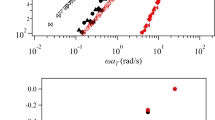Abstract
Thermoreversible gelation of the system 2-propanol/poly (n-butyl methacrylate) — as detected by D'SC or dielectric experiments — does not manifest itself in a straightforward manner in the dynamic-mechanical properties. Its occurrence can, however, be seen in many ways: i) For constant composition of the system and a reference temperature lower than T gel, the storage modulus G′ is larger than the loss modulus G″ in the glass transition zone of the master curve and both vary in an almost parallel manner with the angular frequency ω over almost two decades (whereas this feature is normally found for other gelling systems within the rubber plateau or the flow region). ii) The entanglement molecular weight obtained from G″max is markedly less max than the entanglement molecular weight in the melt divided by ϕ2, the volume fraction of the polymer. iii) The temperature influences change from WLF like to Arrhenius-like behavior as T is lowered in the case of highly concentrated polymer solutions; analogous considerations hold true as ϕ2 is increased at constant T. iv) For sufficiently low temperatures, the activation energy of flow exhibits a maximum in the concentration range where the gelation is — according to DSC experiments — most pronounced. Like with ordinary non-gelling systems it is possible to construct master curves. On the basis of Graessley's theory identical dependencies are obtained for the variation of the entanglement parts of the stationary viscosity with shear rate and for the dependence of the entanglement part of the complex viscosity on the frequency ω of oscillation. Zero shear viscosity and limiting value of the complex viscosity for vanishing ω as a function of ϕ2 match smoothly and exhibit two points of inflection.
Similar content being viewed by others
References
Arrhenius S (1889) Über die Reaktionsgeschwindigkeit bei der Inversion von Rohrzucker durch Säuren. Z Phys Chem 4:226
Ballauff M, Krämer H, Wolf BA (1983) Rheological studies of moderately concentrated polymer solutions in the vicinity of the O temperature. II Shear rate dependence for different thermodynamic conditions. J Pol Sci, Pol Phys Ed 21:1217
Boyer RG, Miller RL (1978) Chain entanglements and chain areas II: a molecular basis for chain entanglements. Rubberchem Tech 51:718
Chambon F, Petrovic ZS, MacKnight WJ, Winter HH (1986) Rheology of model polyurethanes at the gel point. Macromolecules 19:2146
Child WC jun, Ferry JD (1957) Dynamic mechanical properties of poly-n-butyl methacrylate. J Coll Sci 12:327
Cox WP, Merz EH (1958) Correlation of dynamic and steady flow viscosities. J Polym Sci 28:619
Ferry JD (1970) Viscoelastic properties of polymers. Wiley, New York
Fujita H, Maekawa E (1962) Viscosity behavior of the system polymethyl acrylate and diethyl phthalate over the complete range of composition. J Phys Chem 66:1053
Geerissen H, Gernandt F, Wolf BA (1991) Pressure dependence of viscometric relaxation times measured with a new apparatus. Makromol Chem 192:165
Graessley WW (1974) The entanglement concept in polymer rheology. Adv in Polym Sci 16:1
Herold FK, Wolf BA (1983) Non-newtonian flow behavior of poly(decylmethacrylate) solutions. Makromol Chem 184:2539
Irving JB (1977) Viscosities of binary liquid mixtures: a survey of mixture equations. National Engineering Laboratory, East Kilbridge, Glasgow, Report No 630
Ito Y, Shishido S (1978) Non-newtonian flow curves including lower and upper newtonian regions for dilute and moderately concentrated polystyrene solutions. J Polym Sci Phys Ed 16:725
Jelich LM, Nunes SP, Paul E, Wolf BA (1987) On the co-occurrence of demixing and thermoreversible gelation of polymer solutions. 1. Experimental observations. Macromolecules 20:1943
Maderek E, Wolf BA (1988) Viscosity-index and polymer theology. Angew Makromol Chem 161:157
Nielsen LE (1977) Polymer theology. Marcel Dekker, New York
Nunes SP, Wolf BA, Jeberien H-E (1987) On the co-occurrence of demixing and thermoreversible gelation of polymer solutions. 2. Thermodynamic background. Macromolecules 20:1948
Nunes SP, Wolf BA (1987) On the co-occurrence of demixing and thermoreversible gelation of polymer solutions. 3. Overall view. Macromolecules 20:1952
Rouse PE (1953) A theory of viscoelastic properties of dilute solutions of coiling polymers. J Chem Phys 21:1272
Richtering HW, Gagnon KD, Lenz RW, Fuller RC, Winter HH (1992) Physical gelation of a bacterial thermoplastic elastomer. Macromolecules 25:2429
Scanlan JC, Winter HH (1991) Composition dependence of the viscoelasticity of end-linked poly(dimethylsiloxane) at the gel point. Macromolecules 24:47
Schneider T, Wolf BA, Kasten H, Kremer F (1991) Thermoreversible gelation and vitrification of highly concentrated polymer solutions. Macromolecules 24:5387
Schneider T, Wolf BA, Gahleitner M (1994) Solidification behavior of the theta system 2-propanol/poly(n-butyl methacrylate) I. Influences of thermoreversible gelation on stationary flow. Rheol Acta in press
Schurz J (1991) Rheology of polymer solutions of the network type. Prog Polym Sci 16:1
Schurz J (1992) Structure rheological investigations of segment interaction in polymer solutions of the network type. Makromol Chem Makromol Symp 58:153
Vinogradov GV, Malkin AYa, Blinova NK, Sergeyenkov SI, Zabugina MP, Titkova LV, Yanovsky YuG, Shalgemova VG (1973) Peculiarities of flow and viscoelastic properties of solutions of polymers with a narrow molecular-weight distribution. Europ Polym J 9:1231
Weinmann K, Wolf BA, Rätzsch MT, Tschersich L (1992) Theory-based improvements of the continuous polymer fractionation demonstrated for polycarbonate. J Appl Polym Sci 45:1265
Williams ML, Landel RF, Ferry JD (1955) The temperature dependence of relaxation mechanisms in amorphous polymers and other glass-forming liquids. J Am Soc 77:3701
Winter HH, Chambon F (1986) Analysis of linear viscoelasticity of a crosslinking polymer at the gel point. Journal of Rheology 30:367
Wolf BA, Sezen MC (1977) Viscometric determination of thermodynamic demixing data for polymer solutions. Macromolecules 10:1010
Author information
Authors and Affiliations
Rights and permissions
About this article
Cite this article
Schneider, T., Wolf, B.A. Solidification behavior of the theta system 2-propanol/poly(n-butyl methacrylate). Rheola Acta 34, 172–181 (1995). https://doi.org/10.1007/BF00398437
Received:
Accepted:
Issue Date:
DOI: https://doi.org/10.1007/BF00398437




